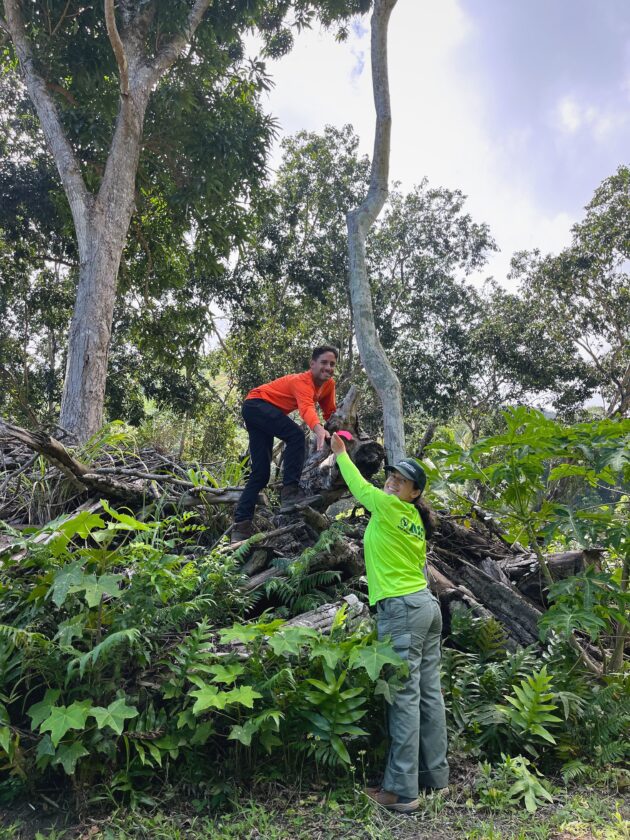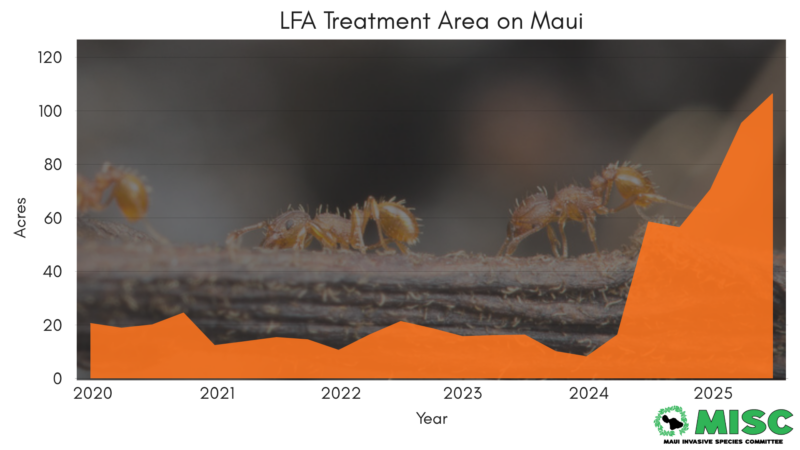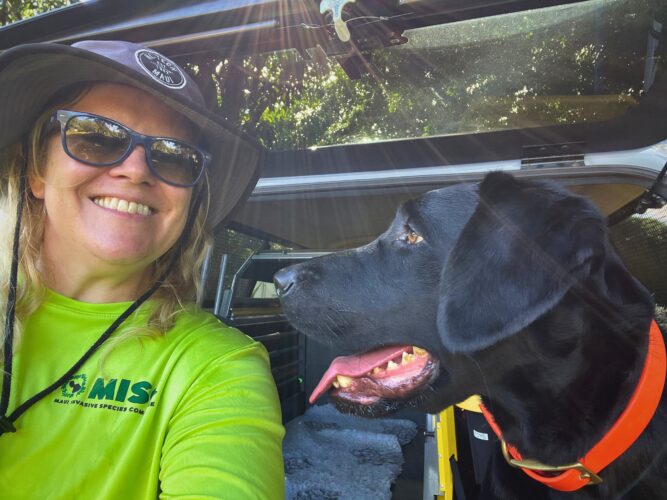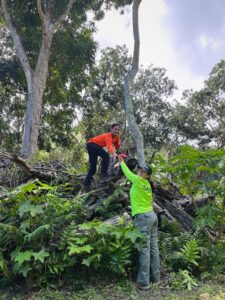Community reports essential as little fire ant detections increase on Maui
With 75% of detections coming from residents, community engagement continues to be the key to protection

MISC crew members search for and treat little fire ants wherever they are found —including in trees and on the ground. Maui Invasive Species Committee/Katie Ernst
The Maui Invasive Species Committee (MISC) is highlighting the critical importance the community plays in protecting the island from little fire ants (LFA). This news comes during October as invasive species response programs across Hawai’i highlight invasive ant awareness during “Stop the Ant” month.
On Maui, 75% of LFA detections come from community reports, proving that the watchfulness of residents is paying off. As LFA populations continue to grow across the state, the attentiveness of residents remains a critical component in preventing the establishment of little fire ants on Maui.
LFA are notorious throughout tropical ecosystems for their ability to outcompete and invade residential areas and rainforest environments. Once established, hundreds of ants can fall from trees, stinging passers-by. It’s not just people who suffer; beloved pets and valuable livestock can go blind after repeated stings.
In 2024, little fire ant detections on Maui surged, reaching a record eight new sites that year. Since the first detection of LFA on Maui in 2009, one or two new sites have been discovered each year, so this sudden jump marks a major change.
“For many years the amount of newly infested area on Maui was about five to ten acres annually, ” explains Monte Tudor-Long, MISC’s Invasive Ant Early Detection and Rapid Response Technician. “Because we were able to eradicate infestations elsewhere, the area being treated stayed steady – between 10 and 20 acres at any given time. But since January 2024, we’ve seen that number jump by around 100 acres.” Most of this new acreage resulted from inadvertent movement of infested material from other sites.

Since 2024, the detection of 8 new little fire ant sites, plus spread from existing sites, has dramatically increased acres requiring treatment. Treatment areas had remained steady at roughly 10-20 acres as populations were eradicated and new ones detected. In 2024, treatment acres jumped to over 100. Note: The graph excludes a 175-acre site in Nahiku that was treated through February 2023. Courtesy photo
“Community awareness is more important than ever,” says Richard Martinez, MISC’s LFA Coordinator. “Homeowners often don’t realize they have an infestation until someone gets stung. By then, the infestation has typically spread across multiple properties.” The average infestation size at detection is five acres. “Proactive community surveys are critical,” Martinez emphasizes.
The newest infestation was reported by residents in Nāpili and covers two acres. “Finding infestations early, before they grow too large or spread into challenging terrain offers the best hope for eradication,” says Martinez.
The good news is that treatments are effective. Using techniques developed by the Hawai’i Ant Lab, MISC has eradicated the stinging ants from nine sites (no LFA have been detected in five years of surveys). Two sites achieved LFA-free status in 2025, including one in Kapalua and a nursery in Kīhei, thanks to successful collaboration with property owners and the community.
In 2024, MISC added a new tool to help find ants at low densities. MISC’s detector dog, Freddie, is a black lab trained in Australia to sniff out little fire ants. His ant-seeking nose turned up no LFA at the Kapalau and nursery sites, helping to confirm the results of surveys by the crews. Freddie and his handler Trisha Dillenburg work at newly-detected sites to find the edges of the infested area. “Freddie helps speed up the survey process by telling us where to look,” says Dillenburg.

Trisha Dillenburg and Freddie, MISC’s detection dog team, search for little fire ants. Since joining in 2024, Freddie has significantly expanded detection capacity. Maui Invasive Species Committee/Trisha Dillenburg
Aerial treatment by helicopter has proven effective in eliminating ants from 175 acres in Nāhiku. In the last year MISC added drones as a tool for treating smaller sites with high canopy tree cover. Currently one site is undergoing drone treatment and there is the potential for additional sites.
Prevention efforts – led by Hawai’i Department of Agriculture and Biosecurity – protect Maui County from LFA and other pests that move interisland on infested materials but community awareness remains key. “That’s why Stop the Ant month remains so important,” says Tudor-Long. “MISC can’t do it alone. This annual reminder to collect and send ants from your yard or home helps us stay in front of the surge of LFA.”
MISC will identify any ant they receive and let the reporter know. “Effective treatment relies on knowing what you’re treating for,” says Tudor-Long. “We can help with ID and direct you to resources.” Community reports of ants have led to the detection of ants new to an area, and “we’re always on the lookout for new species not yet known from Hawai’i,” he explains. “That act of observing the environment helps protect our islands.”
Ant collection kits are available at stoptheant.org or from local garden supply stores around the island. You can find updated information on the status of LFA on Maui at https://stoptheant.org/lfa-on-maui/
The Maui Invasive Species Committee is a project of the Pacific Cooperative Studies Unit of the University of Hawai’i – Mānoa. Grant funding from the County of Maui, Hawaii Invasive Species Council, and private donations supports the work of protecting our community and resources from priority invasive species before they become widespread. Learn more about MISC at mauiinvasive.org.



